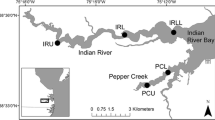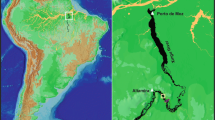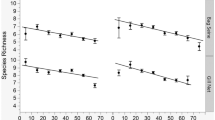Abstract
The growing intensity of anthropogenic activities has led to an increase in the number of studies assessing the effects of stressors on marine ecosystems. Yet, the cumulative effects of multiple stressors are rarely studied although they seldom operate in isolation of each other. Our study aimed to investigate the effects of multiple stressors on fish assemblages in a series of semi-enclosed bays. We quantified fish assemblages using baited remote underwater video across five sites with varying environmental and anthropogenic stressors. We also sampled across two seasons and in protected and unprotected areas. We found that fish assemblages were most influenced by effluent input and aquaculture, but not fishing pressure. Relief, season, salinity, and pH were also included in the best model highlighting the importance of environmental variables in structuring fish assemblages. Total abundance was not affected by anthropogenic stressors but individual species showed variable responses from reduced abundance (e.g. Neoodax balteatus and Cyanea rosella) to increased abundances (e.g. Arripis spp.). We found no evidence that increased number or intensity of stressors affected overall fish abundance or diversity. Our findings highlight the diverse effects anthropogenic stressors can have on fishes with both environmental and anthropogenic influences playing a role in structuring fish assemblages over both short temporal and spatial scales.





Similar content being viewed by others
References
Adams SM (2005) Assessing cause and effect of multiple stressors on marine systems. Mar Pollut Bull 51:649–657. https://doi.org/10.1016/j.marpolbul.2004.11.040
Anderson M, Gorley R, Clarke K (2008) PERMANOVA+ for PRIMER: guide to software and statistical methods. PRIMER-E Ltd, Plymouth
Australian Bureau of Statistics (2016) 2016 Census QuickStats: Coffin Bay
Babcock RC, Shears NT, Alcala AC, Barrett NS, Edgar GJ, Lafferty KD, McClanahan TR, Russ GR (2010) Decadal trends in marine reserves reveal differential rates of change in direct and indirect effects. Proc Natl Acad Sci USA 107:18256–18261. https://doi.org/10.1073/pnas.0908012107
Bergqvist J, Gunnarsson S (2013) Finfish aquaculture: animal welfare, the environment, and ethical implications. J Agric Environ Ethics 26:75–99. https://doi.org/10.1007/s10806-011-9346-y
Bond ME, Babcock EA, Pikitch EK, Abercrombie DL, Lamb NF, Chapman DD (2012) Reef sharks exhibit site-fidelity and higher relative abundance in marine reserves on the Mesoamerican Barrier Reef. PLoS ONE 7:e32983. https://doi.org/10.1371/journal.pone.0032983
Breitburg DL, Baxter JW, Hatfield CA, Howarth RW, Jones CG, Lovett GM, Wigand C (1998) Understanding effects of multiple stressors: ideas and challenges. In: Pace ML, Groffman PM (eds) Successes, limitations, and frontiers in ecosystem science. Springer, New York, pp 416–431
Brooks BW, Riley TM, Taylor RD (2006) Water quality of effluent-dominated ecosystems: ecotoxicological, hydrological, and management considerations. Hydrobiologia 556:365–379. https://doi.org/10.1007/s10750-004-0189-7
Cappo M, Speare P, De’ath G (2004) Comparison of baited remote underwater video stations (BRUVS) and prawn (shrimp) trawls for assessments of fish biodiversity in inter-reefal areas of the Great Barrier Reef Marine Park. J Exp Mar Biol Ecol 302:123–152. https://doi.org/10.1016/j.jembe.2003.10.006
Christensen MR, Graham MD, Vinebrooke RD, Findlay DL, Paterson MJ, Turner MA (2006) Multiple anthropogenic stressors cause ecological surprises in boreal lakes. Glob Change Biol 12:2316–2322. https://doi.org/10.1111/j.1365-2486.2006.01257.x
Clarke K, Gorley R (2015) PRIMER v7: user manual/tutorial. PRIMER-E Ltd, Plymouth
Clarke KR, Chapman MG, Somerfield PJ, Needham HR (2006) Dispersion-based weighting of species counts in assemblage analyses. Mar Ecol Prog Ser 320:11–27
Clarke KR, Tweedley JR, Valesini FJ (2014) Simple shade plots aid better long-term choices of data pre-treatment in multivariate assemblage studies. J Mar Biol Assoc UK 94:1–16. https://doi.org/10.1017/S0025315413001227
Crain CM, Kroeker K, Halpern BS (2008) Interactive and cumulative effects of multiple human stressors in marine systems. Ecol Lett 11:1304–1315. https://doi.org/10.1111/j.1461-0248.2008.01253.x
Deegan LA, Wright A, Ayvazian SG, Finn JT, Golden H, Merson RR, Harrison J (2002) Nitrogen loading alters seagrass ecosystem structure and support of higher trophic levels. Aquat Conserv Mar Freshw Ecosyst 12:193–212. https://doi.org/10.1002/aqc.490
Doubleday ZA, Jones AR, Deveney MR, Ward TM, Gillanders BM (2017) Eight habitats, 38 threats and 55 experts: Assessing ecological risk in a multi-use marine region. PLOS One 12:e0177393. https://doi.org/10.1371/journal.pone.0177393
Econsearch (2016) The economic impact of aquaculture on the South Australian state and regional economies, 2014/15. PIRSA Fisheries and Aquaculture, Adelaide
Ellis D, DeMartini E (1995) Evaluation of a video camera technique for indexing abundances of juvenile pink snapper, Pristipomoides filamentosus, and other Hawaiian insular shelf fishes. Oceanogr Lit Rev 93:67–77
Erbland PJ, Ozbay G (2008) A comparison of the macrofaunal communities inhabiting a Crassostrea virginica oyster reef and oyster aquaculture gear in Indian River Bay, Delaware. J Shellfish Res 27:757–768. https://doi.org/10.2983/0730-8000
Everett RA, Ruiz GM, Carlton JT (1995) Effect of oyster mariculture on submerged aquatic vegetation: an experimental test in a Pacific Northwest estuary. Mar Ecol Prog Ser 125:205–217
Fitzpatrick B, Harvey E, Langlois T, Babcock R, Twiggs E (2015) Effects of fishing on fish assemblages at the reefscape scale. Mar Ecol Prog Ser 524:241–253. https://doi.org/10.3354/meps11077
Forrest BM, Creese RG (2006) Benthic impacts of intertidal oyster culture, with consideration of taxonomic sufficiency. Environ Monit Assess 112:159–176. https://doi.org/10.1007/s10661-006-0359-3
Forrest BM, Keeley NB, Hopkins GA, Webb SC, Clement DM (2009) Bivalve aquaculture in estuaries: review and synthesis of oyster cultivation effects. Aquaculture 298:1–15. https://doi.org/10.1016/j.aquaculture.2009.09.032
Gomon M, Bray D, Kuiter R (2008) Fishes of Australia’s southern coast. Reed New Holland, Sydney
Halpern BS, Warner RR (2002) Marine reserves have rapid and lasting effects. Ecol Lett 5:361–366. https://doi.org/10.1046/j.1461-0248.2002.00326.x
Halpern BS, McLeod KL, Rosenberg AA, Crowder LB (2008) Managing for cumulative impacts in ecosystem-based management through ocean zoning. Ocean Coast Manag 51:203–211. https://doi.org/10.1016/j.ocecoaman.2007.08.002
Halpern BS, Walbridge S, Selkoe KA, Kappel CV, Micheli F, D’Agrosa C, Bruno JF, Casey KS, Ebert C, Fox HE, Fujita R, Heinemann D, Lenihan HS, Madin EMP, Perry MT, Selig ER, Spalding M, Steneck R, Watson R (2008) A global map of human impact on marine ecosystems. Science 319:948–952. https://doi.org/10.1126/science.1149345
Harvey ES, Cappo M, Butler JJ, Hall N, Kendrick GA (2007) Bait attraction affects the performance of remote underwater video stations in assessment of demersal fish community structure. Mar Ecol Prog Ser 350:245–254. https://doi.org/10.3354/meps07192
Heck JKL, Orth RJ (1980) Seagrass habitats: the roles of habitat complexity, competition and predation in structuring associated fish and motile macroinvertebrate assemblages Estuarine perspectives. Academic Press, New York, pp 449–464
Hughes TP, Connell JH (1999) Multiple stressors on coral reefs: a long-term perspective. Limnol Oceanogr 44:932–940. https://doi.org/10.4319/lo.1999.44.3_part_2.0932
Huveneers C, Meekan MG, Apps K, Ferreira LC, Pannell D, Vianna GMS (2017) The economic value of shark-diving tourism in Australia. Rev Fish Biol Fish 27:665–680. https://doi.org/10.1007/s11160-017-9486-x
Hyndes GA, Kendrick AJ, MacArthur LD, Stewart E (2003) Differences in the species- and size-composition of fish assemblages in three distinct seagrass habitats with differing plant and meadow structure. Mar Biol 142:1195–1206. https://doi.org/10.1007/s00227-003-1010-2
Islam MS, Tanaka M (2004) Impacts of pollution on coastal and marine ecosystems including coastal and marine fisheries and approach for management: a review and synthesis. Mar Pollut Bull 48:624–649. https://doi.org/10.1016/j.marpolbul.2003.12.004
Jennings MJ, Bozek MA, Hatzenbeler GR, Emmons EE, Staggs MD (1999) Cumulative effects of incremental shoreline habitat modification on fish assemblages in North Temperate Lakes. N Am J Fish Manag 19:18–27. https://doi.org/10.1577/1548-8675
Kämpf J, Ellis H (2014) Hydrodynamics and flushing of Coffin Bay, South Australia: a small tidal inverse estuary of interconnected bays. J Coast Res. https://doi.org/10.2112/JCOASTRES-D-14-00046.1
Kuiter RH (1996) Guide to sea fishes of Australia. New Holland Publishers, Sydney
Langlois TJ, Harvey ES, Fitzpatrick B, Meeuwig JJ, Shedrawi G, Watson DL (2010) Cost-efficient sampling of fish assemblages: comparison of baited video stations and diver video transects. Aquat Biol 9:155
Langlois T, Goetze J, Bond T, Monk J, Abesamis RA, Asher J, Barrett N, Bernard ATF, Bouchet PJ, Birt MJ, Cappo M, Currey-Randall LM, Fairclough DV, Fullwood LAF, Gibbons BA, Harasti D, Heupel MR, Hicks J, Holmes TH, Huveneers C, Ierodiaconou D, Jordan A, Knott NA, Malcolm HA, McLean D, Meekan M, Miller D, Mitchell PJ, Newman SJ, Radford B, Rolim FA, Saunders BJ, Stowar M, Smith ANH, Travers MJ, Wakefield CB, Whitmarsh SK, Williams J, Driessen D, Harvey ES (2020) A field and video-annotation guide for baited remote underwater stereo-video surveys of demersal fish assemblages. Methods Ecol Evol pp 1–9. https://doi.org/10.1111/2041-210x.13470
Leguerrier D, Niquil N, Petiau A, Bodoy A (2004) Modeling the impact of oyster culture on a mudflat food web in Marennes-Oleron Bay (France). Mar Ecol Prog Ser 273:147–161
Lester SE, Halpern BS, Grorud-Colvert K, Lubchenco J, Ruttenberg BI, Gaines SD, Airame S, Warner RR (2009) Biological effects within no-take marine reserves: a global synthesis. Mar Ecol Prog Ser 384:33–46. https://doi.org/10.3354/meps08029
Lin H-J, Shao K-T, Hsieh H-L, Lo W-T, Dai X-X (2009) The effects of system-scale removal of oyster-culture racks from Tapong Bay, southwestern Taiwan: model exploration and comparison with field observations. ICES J Mar Sci 66:797–810. https://doi.org/10.1093/icesjms/fsp078
Lotze HK, Lenihan HS, Bourque BJ, Bradbury RH, Cooke RG, Kay MC, Kidwell SM, Kirby MX, Peterson CH, Jackson JBC (2006) Depletion, degradation, and recovery potential of estuaries and coastal seas. Science 312:1806–1809. https://doi.org/10.1126/science.1128035
Mallet D, Pelletier D (2014) Underwater video techniques for observing coastal marine biodiversity: a review of sixty years of publications (1952–2012). Fish Res 154:44–62. https://doi.org/10.1016/j.fishres.2014.01.019
McArdle BH, Anderson MJ (2001) Fitting multivariate models to community data: a comment on distance-based redundancy analysis. Ecology 82:290–297. https://doi.org/10.1890/0012-9658
McCauley DJ, Pinsky ML, Palumbi SR, Estes JA, Joyce FH, Warner RR (2015) Marine defaunation: animal loss in the global ocean. Science 347:1255641. https://doi.org/10.1126/science.1255641
McKinley A, Johnston EL (2010) Impacts of contaminant sources on marine fish abundance and species richness: a review and meta-analysis of evidence from the field. Mar Ecol Prog Ser 420:175–191
Moore C, Harvey E, Van Niel K (2010) The application of predicted habitat models to investigate the spatial ecology of demersal fish assemblages. Mar Biol 157:2717–2729. https://doi.org/10.1007/s00227-010-1531-4
Murphy HM, Jenkins GP (2010) Observational methods used in marine spatial monitoring of fishes and associated habitats: a review. Mar Freshw Res 61:236–252. https://doi.org/10.1071/MF09068
Neuman E, Karås P (1988) Effects of pulp mill effluent on a Baltic coastal fish community. Water Sci Technol 20:95–106
O’Brien AL, Dafforn KA, Chariton AA, Johnston EL, Mayer-Pinto M (2019) After decades of stressor research in urban estuarine ecosystems the focus is still on single stressors: a systematic literature review and meta-analysis. Sci Total Environ. https://doi.org/10.1016/j.scitotenv.2019.02.131
Olsson J, Bergström L, Gårdmark A (2012) Abiotic drivers of coastal fish community change during four decades in the Baltic Sea. ICES J Mar Sci 69:961–970. https://doi.org/10.1093/icesjms/fss072
Passadore C, Möller LM, Diaz-Aguirre F, Parra GJ (2018) Modelling dolphin distribution to inform future spatial conservation decisions in a marine protected area. Sci Rep 8:15659
Pierce J (2011) Social sustainability of oyster farming communities on the Eyre Peninsula, South Australia. PhD thesis. University of South Australia, Adelaide
Priede IG, Bagley PM, Smith A, Creasey S, Merrett N (1994) Scavenging deep demersal fishes of the Porcupine Seabight, north-east Atlantic: observations by baited camera, trap and trawl. J Mar Biol Assoc UK 74:481–498
Primary Industries and Regions South Australia (2014) South Australian aquaculture: a summary of its diversity, production and innovation. PIRSA, Adelaide
Read P, Fernandes T (2003) Management of environmental impacts of marine aquaculture in Europe. Aquaculture 226:139–163. https://doi.org/10.1016/s0044-8486(03)00474-5
Robbins WD, Huveneers C, Parra GJ, Möller L, Gillanders BM (2017) Anthropogenic threat assessment of marine-associated fauna in Spencer Gulf, South Australia. Mar Policy 81:392–400. https://doi.org/10.1016/j.marpol.2017.03.036
Ryther JH, Dunstan WM (1971) Nitrogen, phosphorus, and eutrophication in the coastal marine environment. Science 171:1008–1013. https://doi.org/10.1126/science.171.3975.1008
Saunders BG (2012) Shores and shallows of Coffin Bay: an identification guide. Printmax, Adelaide
Shears NT, Ross PM (2010) Toxic cascades: multiple anthropogenic stressors have complex and unanticipated interactive effects on temperate reefs. Ecol Lett 13:1149–1159. https://doi.org/10.1111/j.1461-0248.2010.01512.x
Smith VH (2003) Eutrophication of freshwater and coastal marine ecosystems a global problem. Environ Sci Pollut Res 10:126–139. https://doi.org/10.1065/espr2002.12.142
Strutton PG, Bye JAT, Mitchell JG (1996) Determining coastal inlet flushing times: a practical expression for use in aquaculture and pollution management. Aquacult Res 27:497–504. https://doi.org/10.1111/j.1365-2109.1996.tb01279.x
Teixeira-Neves TP, Neves LM, Araújo FG (2015) Hierarchizing biological, physical and anthropogenic factors influencing the structure of fish assemblages along tropical rocky shores in Brazil. Environ Biol Fishes 98:1645–1657. https://doi.org/10.1007/s10641-015-0390-8
Tovar A, Moreno C, Mánuel-Vez MP, Garcı́a-Vargas M (2000) Environmental impacts of intensive aquaculture in marine waters. Water Res 34:334–342. https://doi.org/10.1016/s0043-1354(99)00102-5
Vargas-Fonseca E, Olds AD, Gilby BL, Connolly RM, Schoeman DS, Huijbers CM, Hyndes GA, Schlacher TA (2016) Combined effects of urbanization and connectivity on iconic coastal fishes. Divers Distrib 22:1328–1341. https://doi.org/10.1111/ddi.12495
Watson D, Harvey E, Fitzpatrick B, Langlois T, Shedrawi G (2010) Assessing reef fish assemblage structure: how do different stereo-video techniques compare? Mar Biol 157:1237–1250. https://doi.org/10.1007/s00227-010-1404-x
Whitmarsh S, Fairweather P, Brock D, Miller D (2014) Nektonic assemblages determined from baited underwater video in protected versus unprotected shallow seagrass meadows on Kangaroo Island, South Australia. Mar Ecol Prog Ser 503:205–218. https://doi.org/10.3354/meps10733
Whitmarsh SK, Fairweather PG, Huveneers C (2017) What is Big BRUVver up to? Methods and uses of baited underwater video. Rev Fish Biol Fish 27:53–73. https://doi.org/10.1007/s11160-016-9450-1
Whitmarsh SK, Huveneers C, Fairweather PG (2018) What are we missing? Advantages of more than one viewpoint to estimate fish assemblages using baited video. R Soc Open Sci 5:171993. https://doi.org/10.1098/rsos.171993
Willis TJ, Millar RB, Babcock RC (2000) Detection of spatial variability in relative density of fishes: comparison of visual census, angling, and baited underwater video. Mar Ecol Prog Ser 198:249–260. https://doi.org/10.3354/meps198249
Wilson SK, Graham NAJ, Pratchett MS, Jones GP, Polunin NVC (2006) Multiple disturbances and the global degradation of coral reefs: are reef fishes at risk or resilient? Glob Change Biol 12:2220–2234. https://doi.org/10.1111/j.1365-2486.2006.01252.x
Wilson SK, Graham NAJ, Polunin NVC (2007) Appraisal of visual assessments of habitat complexity and benthic composition on coral reefs. Mar Biol 151:1069–1076. https://doi.org/10.1007/s00227-006-0538-3
Worm B, Barbier EB, Beaumont N, Duffy JE, Folke C, Halpern BS, Jackson JB, Lotze HK, Micheli F, Palumbi SR (2006) Impacts of biodiversity loss on ocean ecosystem services. Science 314:787–790
Acknowledgements
This paper is dedicated to the legacy of Peter Fairweather, who sadly passed away while the paper was in review. Peter was a great source of inspiration for many generations of marine scientists and we are honoured to have called him our friend and mentor. We would like to thank CEBEL for their support in this project, in particular C. Passadore and F. Diaz-Aguirre for their assistance with fieldwork and data collection and for use of their environmental data. We would also like to thank the volunteers D. Carter and K. Indeck for assistance with fieldwork and B. Saunders for his input into identifying and classifying the stressors in Coffin Bay.
Funding
This work was conducted with support from the South Australian Department for Environment and Water and Holsworth Wildlife Research Endowment.
Author information
Authors and Affiliations
Corresponding author
Ethics declarations
Conflict of interest
All authors declare they have no conflict of interest.
Ethical approval
All applicable international, national, and/or institutional guidelines for the care and use of animals were followed, under permits issued by the Flinders University Animal Welfare Committee (#E403) and from the Department for Environment and Water (marine parks permit #MR00092-2-V).
Additional information
Responsible Editor: S. Hamilton.
Publisher's Note
Springer Nature remains neutral with regard to jurisdictional claims in published maps and institutional affiliations.
Reviewed by undisclosed experts.
Electronic supplementary material
Below is the link to the electronic supplementary material.
Rights and permissions
About this article
Cite this article
Whitmarsh, S.K., Huveneers, C. & Fairweather, P.G. Investigating the cumulative effects of multiple stressors on fish assemblages in a semi-enclosed bay. Mar Biol 167, 171 (2020). https://doi.org/10.1007/s00227-020-03784-w
Received:
Accepted:
Published:
DOI: https://doi.org/10.1007/s00227-020-03784-w




